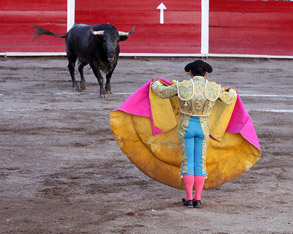Home Page » Post
« Next Article: Watch Out!
» Previous Article: The DELE Exam Is It For Me?
Tuesday, August 17, 2010 (read 82581 times)
Spanish Bullfights - Vocab and everything you need to know
by KimberlyThe Spanish bull - a Spanish symbol and important cultural tradition?
So, you saw or are going to see an encierro, or running of the bulls, and a bullfight. If you are anything like me, you will or have a lot of questions. This blog post is dedicated to clearing up the mystery behind encierros and bullfights and giving you the vocabulary you need to understand what is going on.
First, it is important to know that the encierros do not only take place in Pamplona, as many people might think. They are traditional events in the festivities of many towns and cities throughout Spain, Portugal, Southern France and Latin America. However, the San Fermines festivities in Pamplona are home to the most famous "running of the bulls" in the world.
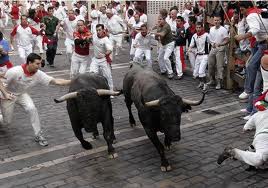
This weekend, however, many Spanish villages were in "fiesta" or celebrations. Among the numerous events celebrated during the festival, it is traditional to have an encierro which typically occurs early on Saturday morning and later the same day a corrida de toros (bullfight).
The following vocabulary is divided into: animals, bullfighters, the bullfight, and names of events. Following the vocabulary is a detailed explanation with pictures about what to expect to see at a Spanish bullfight. Enjoy!
Vocabulary: Animals
Cabestros: Cabestros are male castrated bulls or steer, of a different race than the fighting bulls. They are tamed and used to help on toro bravo ranches. They are also trained to be used in encierros and bullfighting rings to guide the herd through the streets and into their corrals. They are easily identifiable by their non-threatening stature and presence and often wear bells around their neck.
Tienta: both female and male toros are tested at age two to see if they are suitable for breeding, bullfighting, or meat. Males are judged based on their aggression towards horses, as they are not allowed to confront a human on the ground until the day they enter a bullfighting ring. Females are often fully tested by a bullfighter and capes to determine their courage and suitability for breeding. Male bulls who pass the tienta will return to their pastures and females who pass will be used to bear offspring. Those who do not pass are slaughtered.
Novillos: Novillos are those male bulls that are less than 3 years old or do not pass the bravery and stamina test to become first rank fighting bulls. These bulls are used in novilladas to train novilleros.
Toro: a Bull - an Iberian cattle breed. Fighting bulls are selected primarily for a certain combination of aggression, energy, strength, stamina and intelligence They reach maturity slower than meat breeds as they were selected to be athletic with massive muscles, especially the morillo, a complex of muscles over the shoulder and neck which gives the bull its distinctive profile and strength with its horns. The horns are longer than in most other breeds and are also present in both males and females. Mature bulls weigh from 500 to 700 kg (1100-1600 lb)
Toro de Lidia/Toro Bravo: male "macho" fighting bulls selected and bred to be used in encierros (running of the bull) and corridas de toro (bull fights).
Vaquillas/ Novillas: female wild cow of the same breed as the fighting bulls between two and four years old. They are traditionally used in place of fighting bulls or novillos for capeas or encierros in village celebrations because they are much smaller and less likely to cause grave damage.
Vocabulary: Bullfighters
Banderilleros/ Rejoneadores: Each matador has 3 banderilleros or "Flagmen" who are also considered as toreros or bullfighters. They perform in the first and second third of the corrida.
Cuadrilla: A matador and his 6 assistants are collectively known as cuadrilla, or entourage: 2 picadores, 3 banderilleros, and 1 mozo de espada.
Matadores: Matador de toros literally translated as "bull killer" is the professional level of a bullfighter.
Mozo de espada: The matador‘s assistant or "sword page." The mozo de espada prepares and hands the matador all the equipment necessary during the corrida.
Novillero: a junior bullfighter who is still in training and has not yet been declared matador de toros. Novilleros fight novillos to gain experience. These fights usually take place in small towns and villages during their celebrations.
Picadores: Bullfighters or "Lancers," mounted on horseback with varas (lances). During the first stage of the bullfight the picador enters the arena on horseback armed with a vara. The horse is protected from the bull by a petro, a protective mattress-like covering.
Torero: The term torero or "bullfighter" includes matadores, picadores and bandilleros.
Vocabulary: Bullfight
Banderillas Translated literally as "little flags" which are harpoon-pointed colorful sticks that are jabbed into the bull‘s back.
Capote: gold and magenta dress cape used in the first third of the corrida
Descabello: The act of severing the bull‘s spinal cord with a vedugo.
Estocada: a quick sword thrust between the bull‘s shoulder blades and through the heart. This movement is intended to result in a quick and clean death.
Faena: The third stage of the corrida performance with a muleta consisting of a series of tandas.
Indultado: A few times a year a bull will be indultado, or ‘pardoned‘, meaning his life is spared due to ‘outstanding‘ behavior in the bullring. The audience and bullfighter petition its pardon by waving white handkerchiefs. If pardons, the bull is returned to the field where he will live up to 20 to 25 years and be used as a stud.
Lidiar /Torear: Verb "to bullfight" until death
Muleta: small red cape used in the third stage of the Spanish bullfight
Paseíllo: A parade of all the toreros around the arena before a corrida.
Tanda: Series passes between the bull and torero: a typical tanda might consist of three to five basic passes and then a finishing touch, or "remate", such as a "pase de pecho", or "pase de desprecio".
Tercios: A corrida is divided into three tercios or "thirds."
Traje de luces: custom-made and embroidered with silver or golden thread matador costume inspired by by 18th century Andalusian clothing.
Vara/ rejones de castigo: long lance / lances of punishment used by the banderilleros.
Verdugo: a second type of sword used to severe the bull‘s spinal cord to kill it instantly in the event of a failed estocada.
Vocabulary: Bull events
Capeas: Organized events in which vaquillas are released in a plaza and the public can interact with them. Vaquillas are aggressive although much less dangerous than bulls.
Novilladas: Bullfights in which novilleros fight novillos to gain experience. These fights usually take place in small towns and villages during their celebrations.
Encierro: Consists of a running of the bulls through the streets. Runners run down fenced lined streets in front of a small heard of toros, novillos or vaquillas on their way to plaza where they will await the afternoon's bullfight in stalls. Cabestros are often present to guide the herd and also often suffer aggressive attacks from the bravo untamed bulls.
Corrida de toros: A public spectator bullfighting event which occurs in a bullfighting ring. Normally three bullfighters confront 3 bulls each in a corrida.
Spanish Bullfights Stages and Pictures:
The modern corrida is highly ritualized, with three distinct stages or tercios ("thirds"), the start of each being announced by a trumpet sound.
The corrida starts with a parade called paseíllo in which the participants enter the arena to salute the presiding dignitary.
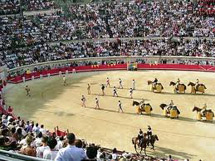
Stage 1 - Tercio de varas ("third of lances")
In the first stage, the bull enters the ring where it will be tested by the matador and banderilleros with the required tanda ("series of passes") using the capote. During this phase the matador observes the bull‘s behavior, how it charges and its ferocity.
Next, two picadores enter the arena armed with a long lance or varas and mounted on large heavily padded and blindfolded horses. When the bull attacks the horse the picador stabs just behind the morrillo, a mound of muscle on the bull‘s neck. The manner in which the bull charges the horse also provides important clues to the matador regarding which side the bull prefers. If successful, the combination blood loss and the force exerted by the bull to lift the horse up with its neck and horns will strain the bull enough to cause it to hold its head lower during the following stages of the bullfight. This is a mandatory step in the corrida which makes the bull‘s charges less dangerous and more reliable, enabling the matador to perform.
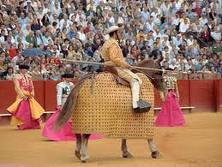
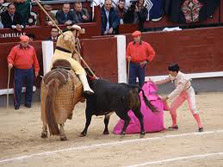
Stage 2 - Tercio de banderillas ("third of flags")
In the next stage, the tercio de banderillas, the three banderilleros each attempt to plant two banderillas, or sharp barbed sticks, into the bull‘s shoulders. The banderillas further weaken the bull but also anger it, cause it to make more ferocious charges. Sometimes the matador places his own banderillas.
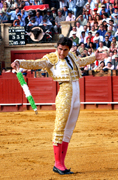
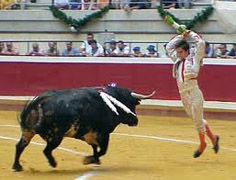
Stage 3 - Tercio de muerte ("the third of death")
In this stage, the matador re-enters the ring with a red cape or muleta stretched over a wooden dowel in one hand and a sword in the other. From the moment the first pass is performed, the matador has a total of 15 minutes to kill the bull.
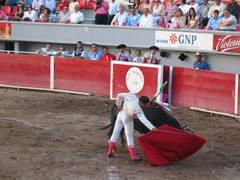
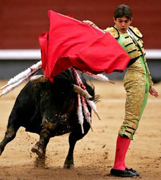
The matador will perform a series of tanda, different series of passes al with specific names that make up the faena, or entire performance with the muleta. The faena ends with a series of passes in which the matador attempts to maneuver the bull into a position to kill it with an estocada, or the thrusting of the sword between the bull‘s shoulder blades and through the heart. A clumsy estocada can raise loud protests and destroy the whole performance.
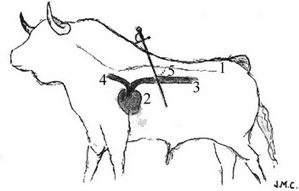
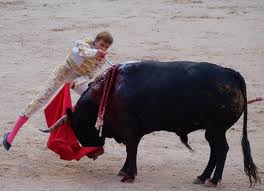
If the matador is unsuccessful in the estocada, a descabello must be performed in which the matador uses a verdugo sword to lower the bull‘s head by pricking its nose and then delivers a quick thrust to the back of the bull‘s neck with the intention of severing its spinal cord to kill it instantly. If the bull does not die immediately a coup de grace is performed by a puntillero or cachetero in which a dagger is used to completely pierce the spinal cord.
The bull‘s body is then dragged out by a team of mules or horses. If the residing official is impressed with the animal, it may be drug around the arena as an honor. Very rarely, a bull may be granted an indulto, or pardon for an outstanding performance. The indulto is requested by the public by waving handkerchiefs before the estocada and must be approved by the president. If pardoned, the bull will be symbolically freed by the matador, which is a great honor. The bull will never fight again as no bull with any experience can ever be used more than once because they learn from experience and thus would be too dangerous.
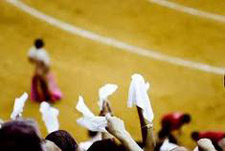
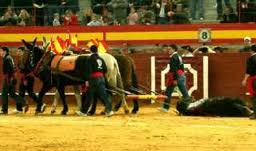
If the matador has performed particularly well, the crowd may petition the president to award the matador an ear of the bull by waving white handkerchiefs. If his performance was exceptional, the president will award two, and in some rings a tail can also be awarded. If the matador won at least two ears during the corrida then he is eligible for salida en hombros, to be carried out on the shoulders of admirers.
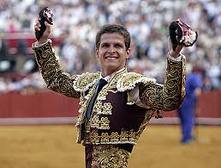
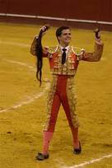
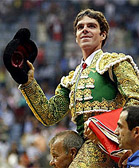
Bullfighter Gorings
Bullfighting has gotten much safer over the years, especially with the introduction of padded protection for the horses and special medical surgical units for the toreros. For toreros, the most dangerous part of the corrida is when they perform the estocada. With no protection, one error can cost life of the matador. Cogidas is the word used when the torero is "gored" by the bull.
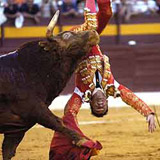
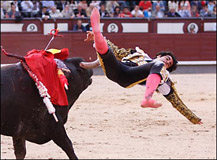
Controversy and Protests
Bullfighting has generated controversy in many parts of the world, including Spain, Portugal, Peru, Mexico and Ecuador. It was even recently< prohibited in Catalonia, an autonomous region of Spain. Supporters argue that it is a cultural tradition and an important source of tourism while animal rights advocates consider it a blood sport that tortures both bulls and horses.
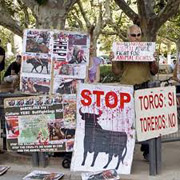
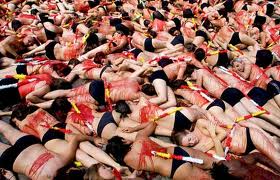
What do you think?
Keywords: spanish bullfights,vocab
Comments
Bull fights, yess... the matador's really REALLY
should wear cowboy clothe's
the outfits are a smudge cheesy.
peace and blessings
I want to see one. Too big a Hemingway fan here, it sounds fascinating. I'm generally all for animal rights but this is such an old tradition, it should kept.
thats a bunch of bull! ...... hahahahahahaha get it?
tie the matador''s down to a specific spot in the ring or let''s let them fight children of other matador''s
So many people comment on bullfighting who know nothing about it. Should read Death in the afternoon which is to my mind the bible of bullfighting.
It''s ridiculous that people are hating on bull fighting. It''s culture from centuries ago. It''s like no one can accept any other culture but their own.
While many may believe this activity brutal and inhumane, I accept it without judging as a part of Spanish culture that has existed for centuries.
I''m certain many cultures worldwide criticize our culture and some of the "sporting" activities that end up critically injuring humans.
I toured bullfights in 1970 in Spain including the complete series at Fiesta de San Fermin. Under Franco''s Spain, the dead bulls were butchered and distributed amongst the people as I understood it. There is an element of cruelty to the spectacle. However, it is a Spanish tradition. If the Spanish decide to ban the tradition, fine. Certainly is their call. But other nationalities should keep their fingers out of the pie. They don''t want to see bullfighting? It''s simple. Don''t go. Many years later I don''t know if I would be as enthusiastic about attending, what with increased sensitivity, I guess. But I also don''t presume to tell the people of another country what they should or should not do in respect to their own cultural traditions.
bullfighting is TORTUREEEEEEEEEEEEEEEEEEEEEEEEEEEEEEEEEEEEEEEEEEEEEEE
Hi I am short of an answer on a quiz I am doing, done loads of searching to no avail, hope you can provide me with an answer ... what is a female matador called ? thanks in advance x x x
Hi, David.
You can call a female matador "matadora" or "torera". Time ago a matadora called Cristina Sánchez became famous. https://en.wikipedia.org/wiki/Cristina_S%C3%A1nchez

